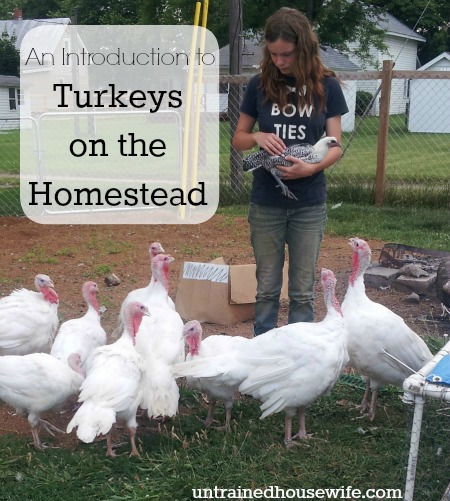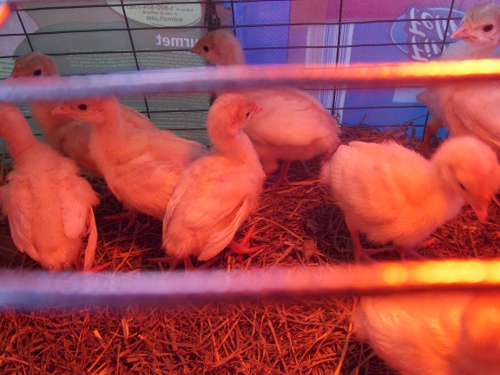We love turkey. For sausage, for burger, for the drumsticks, at Thanksgiving. And, if you have chickens already, adding in a turkey or two on the backyard homestead really isn’t that difficult.
Breeds of turkeys include: Broad Breasted (in white and bronze), Beltsville, Black, Bourbon Red, Bronze, Narragansett, Royal Palm, Slate, and White Holland. They all taste the same — the only difference when butchered is the skin. If they are not white feathered, like the Beltsville and White Holland, you will see the “pin” marks from their feathers on the skin. More on that in the next article, when we get into raising and processing turkeys.
Turkey babies are called “poults” and look like chicken chicks in the beginning. The only difference is their snood, which is just above their beak. You can see it right away, and it looks almost like a pimple at first. You can order them from most local farm supply stores that supply chicks, or you can order online. Meyer and Murray McMurray are two of my favorite places to order poults from. You can order most poults anytime from early March until late August, depending on your turkey needs. We raise ours for 4H, to show them in July, so we get them in early March. A Thanksgiving bird can be ordered as late as August in time for the feast.
Getting ready for poults is the same as getting ready for any breed of poultry. You will need a heat lamp, waterer, feeder, feed, and a warm, dry place for them to live. Turkeys need to eat often, and refreshing their feed multiple times a day will help them eat more. You need as little as 1/2 cup to freshen their food and draw them in, but make sure their feeder is full at all times.
Housing can be very simple for turkeys or very elaborate. In the beginning, when they are small, we protect ours from the other birds in a small run. But, when they get to be about the same size, we let them mingle. We placed some large stumps by the chicken coop, and they like to climb on that to sleep. Shelter for them at this time is a large tarp pulled over four wooden posts. This gives them shade and protection from rain.
Protection from predators for turkeys is important. If you don’t have them in a coop locked up at night, you can hang Christmas tree lights around where they sleep. That has helped us keep raccoons and possums at bay. They don’t like the lights, and don’t come into the yard. Another thing you can do is keep a regular bulb light on a timer for dusk to dawn hours. I just reuse the heat lamp, with a 40 watt bulb replacing the heat bulb.
Processing the turkeys can be done on your own, or they can be taken to a processor. We have done one on our own, and it was so large, and flapped around so much that it is much easier to take to someone else who has the proper equipment for the larger birds.
Turkeys can be a lot of fun. Ours like to flap their wings and chase each other, almost like playing “tag.” They will follow you around, calling for food, or even to be petted. They take dust baths, scratch the ground looking for bugs and worms and act just like chickens. They can also be drama queens and will sulk if they don’t get their way. I have seen a turkey fighting for food, and walk off almost “crying” when it lost the fight to another turkey. It was comical, really. Adding a few turkeys doesn’t take much more time and effort on the homestead, and they make a fun and colorful addition.













Great post! I have been thinking of adding a couple turkeys to our flock to cover out Thanksgiving and Christmas feasts.
Next year we’re adding turkeys (and aquaponics & a dexter cow lol) to our little slice of heaven. Our grandparents have agreed to split the cost for all of the chicken and turkey feed for the year between them in exchange for a pair of turkeys each for the holidays. They’ve moved into the suburbs and can’t grow their own anymore and we moved out to the country so it’s a nice arrangement lol.
Also, I lovelovelove the shirt. It’s always nice to see a fellow Whovian ^_^
That’s a great idea to have someone help split the cost of feed. We always split raising meat chickens with my in laws and it works out really well.